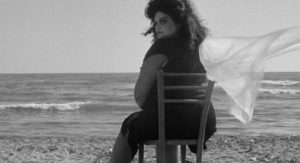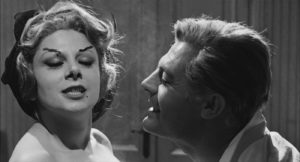While I was reading Jack Babuscio’s description of the term camp and its relation to certain film genres and styles, it reminded me of the film 81⁄2 (Federico Fellini, France/Italy, 1963). As Babuscio writes, “In film, the aesthetic element in camp further implies a movement away from contemporary concerns into realms of exotic or subjective fantasies; the depiction of states of mind that are… suspect; an emphasis on sensuous surfaces, textures, imagery and the evocation of mood as stylistic devices – not simply because they are appropriate to the plot, but as fascinating in themselves.” [1] In 81⁄2, there is not one clear storyline, instead, the film is a mix of realistic and surrealistic (dreams, nightmares, memories of the main hero, metacinema) elements and aims to affect the viewers not with its narrative, but instead, to get a certain emotional response from them. Fellini frames his shots in a way that brings out emotions and feelings, instead of the literal, textual meaning. The film is shot in black and white which adds to its visual value and allows the director to further experiment with framing and lighting, as well as with unusual costumes, hairstyles and make-up of his characters.


Babuscio also states that “Camp is also urban; it is… a reaction to the anonymity, boredom, and socializing tendencies of technological society. Camp aims to transform the ordinary into something more spectacular.” [2] In the first sequence of the film (to which I have attached the link below) demonstrates the transformation of the urban elements – such as a typical long, boring traffic jam with its various vehicles and faces of exhausted drivers – into a “something more spectacular” and extraordinary, such as a vision or a nightmare. The way in which the director uses sound in the scene is unsettling; the same is true about mise-en-scene and editing – we see close-ups of many people that are not relevant to the plot, but never see the face of the scene’s protagonist, only the back of his head, his hands or legs. The nervous, suspenseful tone of the fragment combined with the absence of the soundtrack and indifferent reactions of the people around have a powerful effect on the viewer which is achieved mostly by the use of aesthetical devices, rather than a particular, straightforward plot.
- Jack Babuscio, “Camp and the gay sensebility,” in Queer Cinema: The Film Reader, ed. Harry M. Benshoff and Sean Griffin (New York: Routledge, 2004), p. 124.
- Ibid.
I really like this reading of 8 ½ and agree that it masters the aesthetics to reinforce the surreal moments and breathe life into the dull urban settings. I think the ending is another useful example of camp in this film. The rocket that has been constructed is drab and more akin to a tower of scaffold, yet the scene comes to life in the most serendipitous of fashions as a parade of extras highlight the settings absurdity.